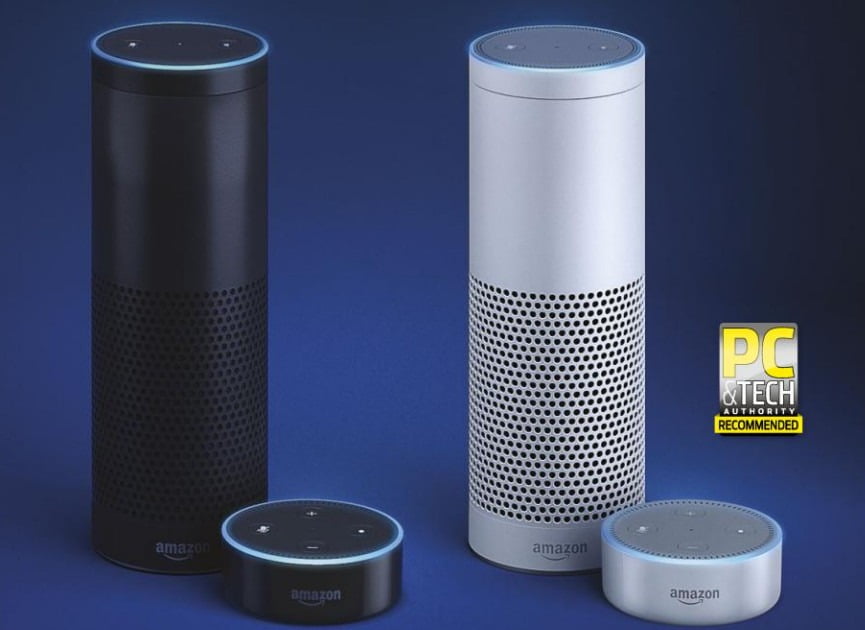FORGET SIRI, CORTANA AND GOOGLE ASSISTANT: THE ECHO IS THE BEST SMART HOME HELPER YET
I’ve never trusted digital voice assistants. Whenever I’ve used Siri, Cortana or Google Now, they either don’t work properly or they’re not quite useful enough to become an integral part of my life. It’s usually quicker to type a query into Google or open up a relevant app, which comes with the added advantage of not looking like an idiot as I bark orders at my phone.
Truth be told, I still feel a bit of an idiot talking to the Amazon Echo, home to a voice assistant powered by the company’s own Alexa engine. And yet, this is the first time that I’ve been convinced by any such technology: not only does it work well, the way it works is so much more natural than its phone-based rivals.
BETTER BY DESIGN
Rather than relying on the microphones inside your phone, Echo is a 360-degree speaker that uses Amazon’s far-field voice-recognition technology to help listen through the noise of everyday life.
It intelligently filters out general household chatter to deliver news, calendar updates, music, traffic information, sports results and answers to various questions on demand. It can struggle with loud background music or when the phone is ringing, but for the most part it responds quickly and on the first time of asking. Even against the usual hum of background noise and voices.
This is no doubt due to the Echo’s seven dedicated microphones. Six are placed at equal intervals around the top of the speaker and one in the middle, so it can hear you from every direction. This allows you to place it in the centre of a room, or off to the side, without jeopardising its listening abilities. You can tell it’s working, too, as the blue light ring along the top will change to a lighter shade of sky blue around the relevant microphone when it’s listening to you, providing a neat indication that it knows where you are.
FEATURE-FILLED
It’s easy to set up, too. While you’ll mainly be interacting with Echo via voice commands, there’s also an Alexa app that acts as Echo’s main control centre. Here, you’ll be able to connect Echo to your home network and set your wake word, which you’ll need to say every time you want to interact with it. It’s “Alexa” by default, but you can also switch it to Amazon or Echo if you prefer.
The app – available for iOS, Android, Amazon; but not Windows Phone – feels like it needs to be stripped down. It’s packed with too many options, which makes it difficult to navigate. What it does offer is additional features.
For example, it gives you a complete rundown of each and every request you’ve asked Alexa, as well as several different menu screens for managing Echo’s various functions. There’s a Now Playing list for when you’re listening to music, a Music and Books tab for setting up Prime Music, Spotify Premium, Tuneln Radio and Audible, options for setting a timer and alarm, a Skills list (more on that shortly), and a Smart Home menu. You can also peruse the Shopping and To-Do lists that you’ve dictated to your Echo.
The Smart Home menu can be used to control compatible thermostats and light bulbs, and there’s support for Nest, Netatmo, Samsung SmartThlngs, Honeywell, Hive, Tado, TP-Llnk’s Kasa, and LIFX lightbulbs. These work well, as evidenced by Jon Honeyball’s experience on pll4. You may even be Inspired to buy some smart light bulbs to take advantage.
LEARNING NEW SKILLS
Even if you don’t yet own any smart home gadgetry, Echo still has a pretty Impressive feature-set, and its Skills list allows you to further expand its abilities. Think of these as additional, third-party apps. You’re limited to what’s available in Amazon’s Skills Store, of course, but there’s still a decent selection available.
For instance, news site skills give you brief headline summaries from your favorite source. There are also recipe tutorials from Jamie Oliver. Then there’s Skyscanner Flight Search, Laundrapp and Uber to name but a few.
It isn’t perfect, though, as Amazon is still missing support for a few key services. For instance, Avid Evernote or Google Keep users will be disappointed to learn that you can only use Amazon’s shopping and to-do lists. There’s always hope a Keep or Evernote skill might become available in the future. After all, if it can tap Into Google Calendar as your main schedule and appointment tool, then hopefully Keep integration won’t be too far behind.
Plus, as we describe In a special article dedicated to Alexa next month, it’s possible to write your own skills to plug the gaps.
However, the key to getting the most out of Alexa is learning how to talk to it properly. While It’s certainly very good at picking up natural rhythms of speech, such as “Alexa, how’s my commute looking?” or “Alexa, what’s the news this morning?’’, there are times when you must be specific.
For instance, to get news from The Guardian (because it’s a skill rather than built-in), you have to ask Alexa to “Open the Guardian” and then go through its instructions. Likewise, it can sometimes mistake words or phrases for others -“news” instead of “Muse”, or “lifeline” instead of “Lang Lang”.
To give an example of how things can go wrong, consider asking Alexa to restart a particular album. Sometimes “Alexa, restart” will replay the album if you’re already playing a song, but other times the same command will only repeat that particular song. “Alexa, replay this album” also tends to only repeat the song. Amazon does try to help by providing a specific commands in the “Things to Try” section of the Alexa app, but the list is hardly exhaustive.
Once you’ve figured out its quirks and limitations, though, using Alexa becomes second nature; you soon learn how to phrase common requests correctly. It just takes a while to get used to, especially if, like me, you’re used to having a lot of information in front of you on a screen the whole time. For example, remembering what you do and don’t have in your music library off the top of your head Is quite a different thing to clicking on a playlist on your PC.
THE SOUND OF SUCCESS?
Fortunately, the Echo is such a good speaker that you may find it usurps your existing way of listening to music and radio. Its cylindrical design lends itself well to projecting music around the room, while its 2in tweeter and 2.5in woofer work well together to produce a clean, balanced sound. It can be neutral in tone, but that’s no bad thing. It’s neither too warm or too boom in rock and pop songs, voices are clear and intelligible, and music sounds pleasingly crisp and detailed.
Busy orchestral works didn’t fare quite so well, with instruments becoming muddled at higher volume levels, but It’s certainly no worse than other Bluetooth speakers I’ve listened to at this price, including Panasonic’s SC-AU05. Likewise, Lang Lang’s rendition of Lizst’s Liebestraum No 3 was a touch restrained at times, sounding a little soft In places as opposed to being tight and controlled.
When you start looking at the Echo as a high-quality speaker first, voice assistant second, that price starts to look compelling. It’s far more natural to use than voice assistants I’ve tried In the past, and the fact it’s already sitting there on a shelf means 1 don’t have to spend time getting my phone out to check the news or weather. I can simply ask a question and Echo will give me an answer. Likewise, voicing playlist requests is much simpler than trying to connect a laptop or phone over Bluetooth.
It also has the potential to excel as a smart home controller: drawing together all these disparate services could be one of Echo’s greatest achievements if, as all signs so far suggest, it does it right. What’s more, Amazon has also launched its smaller, 2nd-gen Echo Dot devices (see our review, above right), so you can spread its skills all around your home.
The Amazon Echo certainly does a lot of things right. You’ll get more out of it as a Prime customer – and a Spotlfy Premium account holder, for that matter. However, if you like the Idea of having a virtual butler at your beck and call to manage your shopping list, read your kids audio books, play music, and generally have something to show off to your friends, then – for once – this is a piece of smart home technology that’s worth its asking price.
Sasha Muller
The Echo isn’t horribly expensive, but if you want one in every room then the cost will quickly rack up. Amazon’s answer Is the cut-down Echo Dot – the hockey-puck-shaped appliance pictured opposite.
It’s far more affordable than the Echo, yet it can do all the same tricks. The same seven-microphone array picks up commands from anywhere in the room, and the Dot can access all the same services, devices and skills as its sibling.
What’s missing is the woofer: the Dot can talk and play music just like the full-sized Echo, but its tiny built-in speaker is much quieter, and wholly lacking in bass. Still, it’s good enough for a kitchen or bedroom, and for more juice you can connect an external speaker, via Bluetooth or the Dot’s 3.5mm jack socket.
The only other socket is a micro-USB connector, over which the Dot draws power. There’s no battery, so the cable must stay connected at all times, which may limit your positioning options. In theory, you could use a USB power bank rather than a mains adapter, but don’t expect it to last more than a few days.
It’s easy to think of the Echo Dot as the junior member of the Alexa family, and Amazon is evidently marketing it as a way to extend voice coverage into the secondary spaces in your home. It’s even offering Dots in packs of six, for a discounted price.
But since the Dot can do everything the full-fat Echo does, it doesn’t have to be a sidekick. It’s a perfectly good way to try out Alexa at a low initial cost, especially if you already own a Bluetooth speaker. You can always add an Echo later once you’re hooked.
KEY SPECS
2×2 MIMO 802.11n Wi-Fi • Bluetooth with A2DP support • 7-microphone array • 2.5in woofer • 2ln tweeter • lyr warranty • external power adapter • 83.5 x 83.5 x 235mm (WDH) • 1.06kg







The Amazon Echo is a voice-controlled device that plays music, searches information, controls other smart home devices, and much, much more! It’s currently one of the most popular gadgets around. Wouldn’t it be awesome to see what the fuss is all about?!